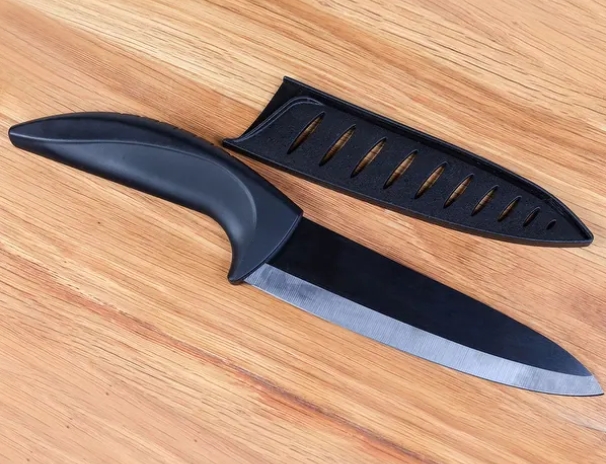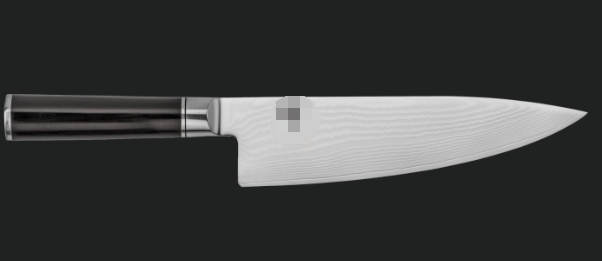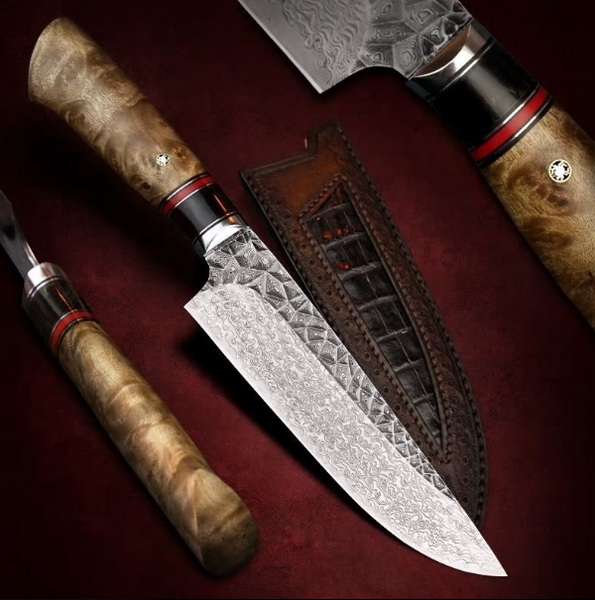

Views: 222 Author: Ella Publish Time: 2025-04-16 Origin: Site








Content Menu
● The Philosophy Behind the Blades
>> Western Knives: Versatility and Durability
>> Japanese Knives: Precision and Specialization
● Materials: Steel, Hardness, and Edge Retention
>> Edge Angle
● Common Knife Types: Western vs Japanese
● Cutting Techniques and Culinary Applications
● FAQ: Western vs Japanese Kitchen Knives
>> 1. What is the main difference between Western and Japanese kitchen knives?
>> 2. Which knife stays sharp longer, Western or Japanese?
>> 3. Can I use a Japanese knife for everything in the kitchen?
>> 4. How should I maintain and sharpen my Japanese knife?
>> 5. Are Western or Japanese knives better for beginners?
Choosing the right kitchen knife is a decision that shapes your cooking experience, efficiency, and even the flavors you create. The debate between Western and Japanese kitchen knives is not just about aesthetics or tradition—it's about design philosophy, steel science, and culinary culture. In this in-depth guide, we'll explore the essential differences between Western and Japanese kitchen knives, their unique strengths, and how to choose the right blade for your kitchen. Throughout the article, you'll find images and videos to help you visualize these differences and master your knife skills.

The kitchen knife is the chef's most essential tool. Whether you're preparing a delicate sashimi platter or breaking down a roast chicken, the right knife makes all the difference. Western and Japanese knives have evolved in parallel, each reflecting the culinary traditions and ingredients of their cultures. Understanding what sets them apart will help you make informed choices and elevate your cooking.
Western knives, often referred to as European or German knives, are designed as robust, all-purpose tools. Their construction prioritizes durability and versatility, allowing them to handle a wide range of kitchen tasks—from chopping dense root vegetables to slicing through bone-in cuts of meat. The culinary tradition in the West emphasizes hearty dishes and a variety of ingredients, which is reflected in the knife's design[2][4][11].
Japanese knives, by contrast, are rooted in a culture that prizes precision and presentation. Japanese cuisine often involves delicate cuts, thin slices, and meticulous preparation. As a result, Japanese knives are typically lighter, sharper, and more specialized, with each knife tailored for specific tasks like slicing sashimi, chopping vegetables, or filleting fish[3][5][10].
- Western Knives: Commonly made from stainless steel or softer carbon steel, Western knives are engineered for toughness and resistance to chipping. The steel is often tempered to a Rockwell hardness between 52 and 58 HRC, balancing edge retention with durability[1][10][13].
- Japanese Knives: Japanese knives use harder steel, often with higher carbon content. This results in blades that are sharper and hold their edge longer, but are also more brittle and susceptible to chipping if misused. Their Rockwell hardness typically ranges from 58 to 65 HRC[1][3][10].
| Feature | Western Knives | Japanese Knives |
|---|---|---|
| Steel Hardness | 52–58 HRC | 58–65 HRC |
| Edge Retention | Moderate | High |
| Toughness | High | Moderate to Low |
| Chipping Risk | Low | High |
- Western Knives: Typically feature a double-bevel edge, sharpened symmetrically on both sides at an angle of about 20 degrees. This makes them ambidextrous and easier to maintain[1][12].
- Japanese Knives: Many traditional Japanese knives use a single-bevel edge (sharpened on one side only), allowing for extremely fine, precise cuts. Even double-bevel Japanese knives are sharpened at a more acute angle (15–16 degrees), resulting in a sharper edge[10][12].
- Western Knives: Thicker, heavier blades that excel at “rock chopping” motions and can withstand heavier use[2][13].
- Japanese Knives: Thinner, lighter blades designed for slicing and push-cutting, ideal for precision work[3][5].
| Feature | Western Knives | Japanese Knives |
|---|---|---|
| Edge Type | Double-bevel (symmetrical) | Single or double-bevel |
| Edge Angle | 20° | 15–16° |
| Blade Thickness | Thick | Thin |
| Cutting Motion | Rocking | Slicing/Push-cutting |

| Knife Type | Description | Image Example |
|---|---|---|
| Chef's Knife | All-purpose, broad blade, curved for rocking motion. | Paring Knife |
| Knife Type | Description | Image Example |
|---|---|---|
| Gyuto | Japanese equivalent of a chef's knife, thinner and sharper. | Santoku |
- Typically constructed from two pieces of wood or composite material, riveted to a full tang (the blade extends through the handle).
- Designed for balance and durability, often heavier and more contoured for a secure grip[1][13].
- Usually lighter, made from wood or composite, and often feature a partial tang.
- Traditional Japanese handles (wa-handle) are cylindrical or octagonal, promoting agility and a lighter feel[10].
| Feature | Western Handles | Japanese Handles |
|---|---|---|
| Tang | Full tang | Partial tang |
| Material | Wood/composite, riveted | Wood/composite, friction-fit |
| Shape | Contoured, ergonomic | Cylindrical/octagonal |
| Weight | Heavier | Lighter |
- Rocking Motion: The curved blade facilitates a rocking motion, making it easy to chop herbs, dice onions, and slice through tougher foods.
- Versatility: Designed to handle a wide range of ingredients, including bones and dense vegetables[2][13].
- Push-Cutting and Slicing: The thinner, sharper blade excels at push-cutting and slicing, ideal for precision tasks like preparing sashimi or finely dicing vegetables.
- Specialization: Many Japanese knives are highly specialized for specific tasks, such as the Yanagiba for sashimi or the Nakiri for vegetables[3][5].
- Sharpening Angle: 20 degrees, easier to sharpen with common honing rods and sharpeners.
- Durability: Softer steel is less prone to chipping, but requires more frequent sharpening[10][12].
- Sharpening Angle: 15–16 degrees, often requires whetstones and more skill to maintain the fine edge.
- Edge Retention: Harder steel means less frequent sharpening, but greater risk of chipping if misused[1][10].
Western and Japanese kitchen knives are both masterpieces of culinary engineering, each excelling in different aspects. Western knives are robust, versatile, and forgiving—perfect for cooks who value durability and multitasking. Japanese knives, with their razor-sharp edges and specialized forms, are ideal for those who prioritize precision, finesse, and the art of cooking.
Your choice ultimately depends on your cooking style, the ingredients you use most often, and your personal preferences. Many chefs opt for a blend of both, using Western knives for heavy-duty tasks and Japanese knives for delicate, precision work.

The main difference lies in the design philosophy: Western knives are built for versatility and durability, with thicker, softer blades and a curved profile for rocking cuts. Japanese knives are designed for precision and sharpness, featuring thinner, harder blades and specialized shapes for specific tasks[1][10].
Japanese knives generally stay sharp longer due to their harder steel and finer edge angle. However, this also makes them more brittle and susceptible to chipping if misused[1][10].
While Japanese knives excel at precision tasks, they are not ideal for heavy-duty jobs like cutting through bones or hard squash. For such tasks, a Western knife is more appropriate due to its thicker, tougher blade[10][12].
Japanese knives should be sharpened at a 15–16 degree angle using a whetstone. Avoid using honing rods or pull-through sharpeners, as these can damage the fine edge. Always hand-wash and dry your Japanese knives to prevent rust and corrosion[10][12].
Western knives are generally more forgiving for beginners due to their robust construction and ease of maintenance. Japanese knives require more careful handling and maintenance but reward the user with unmatched sharpness and precision[10][11].
[1] https://www.seriouseats.com/western-versus-japanese-style-chefs-knives-6751328
[2] https://www.knifeopedia.com/western
[3] https://www.zwilling.com/us/knives/japanese-knives/
[4] https://www.musashihamono.com/blogs/knowledge-japanese-chef-knife/the-charms-and-types-of-westernknives
[5] https://sharpedgeshop.com/blogs/knives-101/types-of-japanese-kitchen-knives
[6] https://www.istockphoto.com/photos/japanese-knife
[7] https://www.youtube.com/watch?v=xqgW-nFJIOw
[8] https://www.youtube.com/watch?v=UPcdZeviMVk
[9] https://whattocook.substack.com/p/the-knife-skills-guide-video-tutorial
[10] https://nakano-knives.com/blogs/blog-posts-1/the-difference-between-japanese-and-western-knives
[11] https://www.curated.com/journal/3282000/an-expert-guide-to-western-knives
[12] https://www.silverback-knives.com/fr/pages/japanese-knives-vs-western-knives
[13] https://www.newwestknifeworks.com/products/8-western-chef-knife
[14] https://zahocho.com/blogs/japanese-knife-101/japanese-knives-vs-western-knives
[15] https://www.reddit.com/r/chefknives/comments/jwi5mt/western_vs_eastern_knives/
[16] https://www.chuboknives.com/blogs/news/the-difference-between-japanese-and-western-knives
[17] https://oishya.com/journal/guide-japanese-kitchen-knife-types-styles/
[18] https://bernalcutlery.com/collections/western-kitchen-knives
[19] https://www.chefsarmoury.com/pages/kitchen-knives-by-type
[20] https://kazsknifeonline.com.au/blogs/knife-knowledge-and-information-1/comparing-western-japanese-chef-s-knives
[21] https://www.kap-kam.com/en/glossary/western-kitchen-knife/
[22] https://www.chuboknives.com/blogs/news/japanese-knife-types-and-how-to-use-them
[23] https://japanesechefsknife.com/collections/western-style-knives
[24] https://dreamofjapan.com/blogs/japanese-knife-stories/eight-types-of-japanese-knives-and-how-to-use-them
[25] https://knifewear.com/blogs/articles/western-knives-vs-japanese-knives-a-primer
[26] https://www.korin.com/about-western-knives
[27] https://www.globalcutleryusa.com/classic-g-2
[28] https://schoolofsushi.com/japanese-knives-vs-western-knives-which-is-best-for-your-kitchen/
[29] https://www.youtube.com/watch?v=FDNNG9doFe4
[30] https://www.youtube.com/watch?v=zyLif-chWe0
[31] https://global.ichimonji.co.jp/collections/western-knife
[32] https://oishya.com/journal/top-10-expensive-knives-world/
[33] https://www.youtube.com/watch?v=bTdkJG-ITo4
[34] https://www.japanesefoodreport.com/posts/videos-japanese-knife-skills
[35] https://www.youtube.com/watch?v=W8jOPRa4HAE
[36] https://www.japanese-cutlery.com/types/kitchen-knife/western-handle-kitchen-knives/custom-western-kitchen-knives/